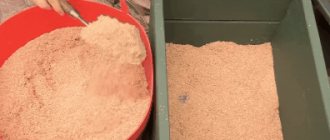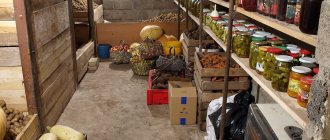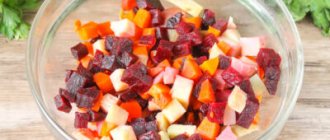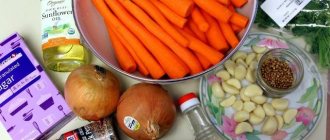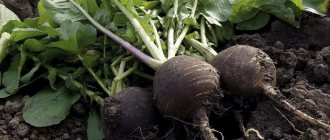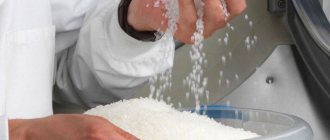Beneficial features
Carrots are very rich in vitamins and microelements . The content of some of them is superior to other vegetables, milk and even meat.
It contains:
- B vitamins;
- vitamin C;
- carotenoids;
- flavonoids;
- anthocyanidins;
- fatty oil;
- essential oil.
The benefits of carrots do not decrease after heat treatment ; on the contrary, new unique properties appear in them. Cooking reduces the amount of lipids, proteins and dietary fiber. This makes it easier for the body to digest. B vitamins and carotenoids remain in the same amount. With regular use of boiled vegetables, intestinal function and the immune system improve.
Raw carrots are low in calories, which makes them indispensable in various diets. To maintain good vision, you need to eat 200 grams of carrots daily.
Suitable for long-term storage
Unfortunately for many gardeners, this vegetable has a very thin and delicate skin . The root crop begins to deteriorate and rot at the slightest violation of its integrity due to the ingress of bacteria and fungi. One of the important rules for quality storage is the absence of damage to the peel and the choice of special, late-ripening and mid-ripening varieties of carrots.
Attention : Rosal, Samson, Typhoon, Gribovchanin F1, Monanta, Canada F1, Mango F1, and many other similar varieties are perfectly stored.
If storage conditions are unsuitable, carrots will rot or sprout. To avoid crop loss, it is important to prepare a suitable room before planting root crops. Some of the prerequisites are:
- preliminary removal of the old harvest;
- disinfection of storage premises;
- whitewashing walls;
- ventilation.
The ideal temperature for storing carrots is from 0 to +3 degrees . Humidity is not higher than 96%. Only well-dried vegetables without tops or signs of spoilage should be put into the basement or boxes. When storing tops from root crops, moisture and vitamins are lost.
The varieties with shortened root crops deteriorate the fastest.
Carrots - varieties for storage
It is best to store ripe carrots, smooth and without cracks. The ripening period depends on both the variety and the growing region. If you live in a cold region - in Siberia or the Urals, then you are better off growing medium-ripening carrots, which last about 100 - 110 days.
Late-ripening varieties have a longer development period, more than 120 days, and in cold regions these carrots may simply not ripen to a state suitable for storage in winter.
There are specially bred varieties of carrots for winter storage:
Golden Autumn, Queen of Autumn, Monastic, Cascade, Narbonne, Flaccoro, Red Giant, Chantane, Valeria, Moscow Winter, Incomparable, Flacque. Any of them deserves to be grown in your garden.
If you cannot remember what type of carrots you planted, then it is better to navigate by the shape of the root crops. Medium-sized, conical root vegetables are best stored in winter. Round, short-fruited varieties are stored worse.
Queen of Autumn
Moscow winter
Carrot Nantes
Is it possible to save in a sandy environment in a basement or cellar?
Storing the carrot harvest in sand is one of the most popular methods among summer residents who have separate basements, cool cellars and garage pits. The method is so common that the question will most likely arise, how to preserve the vegetable without sand? This method is popular due to the ability of a sandy environment to reduce the evaporation of moisture from carrots, thereby preventing the development of rot.
A constant temperature is also ensured, which contributes to the excellent preservation of root crops. Therefore, using sand is not only possible, but also necessary if you want to enjoy a rich harvest of healthy root vegetables all winter.
Which should it be: dry or wet?
What kind of sand is needed and is better suited for storage in the cellar - dry or wet? Is it possible to hope that carrots will remain in wet conditions until spring?
Of course, it is better to moisten the sandy storage medium . This will preserve the juiciness of the vegetable for a long period. This also helps maintain optimal temperature.
Features of storing carrots in sand and which one is better to choose for this: dry or wet
Carrots are a real garden beauty, but keeping them fresh for use in winter is quite difficult. Root vegetables are capricious and demanding on storage conditions. Fruits are especially susceptible to germination and fungal infection (they begin to rot).
How to keep carrots fresh and tasty until next season? What kind of sand should be stored: dry or wet? You will find answers to questions in the article.
Advantages and disadvantages
Among the features of this method, it should be noted that the sand should not be too wet. You can check this by squeezing it in your hand - water should not flow from it and it should not crumble. As the sand layer dries, it is slightly moistened.
The undeniable advantages of using sand are:
- “Warming” carrots in a cold cellar, or cooling when a large amount of warm air penetrates.
- Removing moisture from itself in order to avoid the formation of rot.
- Long shelf life – from 6 to 8 months.
The disadvantages include the need to thoroughly rinse root vegetables before use . There is also a fairly significant investment of time and effort.
Can this material be used?
Sanding technology is popular among gardeners who have a cool basement, cellar or garage pit.
Storage in sand is faster and more convenient than storage in clay solution. Sand allows you to maintain a certain temperature, minimizes moisture evaporation, processes carbon dioxide and has a preservation effect on carrots. This material will also prevent fungus from developing.
Wet or dry: which is better?
Wet sand will prevent the peel from drying out - the carrots will remain fresh and juicy until spring. For 1 bucket of sand, 1 liter of water is enough. Checking the humidity level is quite simple: you need to squeeze the sand and knead it in your hand. The material should not crumble and water should not leak from it.
How to properly preserve vegetables?
To better preserve root crops, you must adhere to the following points:
Before storing carrots, they must be dried in the shade, exposed to air for 2-3 days.- The tops must be cut flush with the head to prevent germination.
- For storage, you should choose fruits of medium and large size, without damage or cracks.
- It is important not to store carrots with any flaws. It is better to use spoiled root vegetables first for pickling cabbage or eating.
- When storing in a box, the bottom must be covered with cellophane or any film. First make several holes in it for air to enter.
- Cover the bottom of the box with a 2-3 centimeter layer of sand.
- Arrange the carrots so that the roots do not touch each other. This is important because the carrots need to breathe.
- Sprinkle about 10 centimeters of sand on top.
- Alternate in this way until the capacity of the container is completely used.
- It is best to cover the top with a lid.
When storing in a bucket, it is better to fill the bottom with dry sand, a layer of about 10 centimeters . Insert the carrots with the cut head up. Cover with already wet sand on top.
Watch a video about storing carrots in sand:
An alternative filler when storing carrots in boxes can be sawdust or moss.
Stage of preparation of vegetables, sand and basement
When using this storage method, it is recommended to follow a number of rules when preparing root crops, follow the advice on choosing sand and processing the cellar or basement.
When preparing vegetables, it is important to take into account factors that can negatively affect preservation; how to store carrots in the basement and avoid mistakes when storing the product for the winter, the following features will help you understand: the shelf life of carrots is affected by the moisture content of the sand, the root vegetables themselves and the presence of damage on them, condition of the bulk material.
It’s bad if the root vegetables are raw. Is it possible to store carrots in this condition - definitely not. After harvesting, root crops must be allowed to dry thoroughly. Then it is recommended to clean each vegetable from the soil and sort it out. The tops are cut almost to the very root. As a rule, only the tips of about 1-1.5 cm are left.
When sorting, those specimens that have dark spots, damage or signs of rot are rejected. It is best to sort root vegetables by size. They must be placed in containers in such a way that they do not come into contact with each other.
Preparing a basement or cellar is also an important process that affects the preservation of carrots during the cold season. Before storing vegetables for the winter in the basement, it is worth cleaning, treating the walls from mold and taking sanitary measures to get rid of insects and rodents. In order for carrots to be stored in the cellar for a long time, it is necessary to create optimal microclimate conditions in it:
- The recommended temperature in the basement or cellar is within 0...+3°C.
- Air humidity should not exceed a maximum of 95%.
The choice of sand should be taken responsibly.
The collected material must be sifted and, if possible, heated, since it must be clean and not contain bacteria potentially dangerous to carrots. Experienced gardeners recommend choosing sand mixed with clay or adding a little crushed chalk to it. As moisture evaporates from the carrots, the sand will absorb it. Clay or chalk will act as natural preservatives.
When using a storage mixture with chalk, root vegetables should be placed vertically with the tops up. The vegetable is stored in damp, dry sand. It is strictly not recommended to use it wet.
The normal consistency of the bulk base can optimize temperature conditions. Carrots are sensitive to temperature changes. If it gets very cold, it may begin to rot. The heat causes the vegetable to sprout.
Which should it be - dry or wet?
A dilemma may arise during the storage process - to sprinkle the vegetable with wet or dry sand. In this case, opinions were divided on what kind of sand to fill carrots with for the winter. Some gardeners believe that it is more acceptable to use dry material. Then the carrots will give off moisture while lying down, and the sand will absorb it. If it is wet, the vegetable will begin to rot.
Others, on the contrary, believe that wet sand can keep vegetables juicy and elastic longer. The proportions for the wet composition in which root vegetables are stored well and in which it is better to store carrots are as follows: take 1 liter of water for 1 bucket of sand with a volume of 10 liters. If you use a box with a volume of up to 15 kg, then you need a little more liquid - 1.5 liters of water.
Using this storage method, you can enjoy the healthy product throughout the winter and not be afraid that the harvest will spoil.
Possible problems
Problems may arise if the crop was grown in soil with a high content of nitrogen and organic fertilizers. Also, excessive watering and late harvesting have a detrimental effect - all this will affect the quality of carrot storage. Among possible diseases, white and black rot can cause great harm to fruits.
The main sign of infection:
- rotting of the top;
- the appearance of dark spots and transverse stripes on the peel with the formation of voids under them.
For these reasons, the pulp becomes rotten and the carrots quickly deteriorate. The source of the disease is infected planting material or old crops in the basement .
It is worth noting that infection will spread faster with high humidity and elevated temperatures in the basement or cellar. Rot develops in patches and quickly passes from diseased root crops to healthy ones.
Important : It is necessary to notice the first signs in a timely manner and throw away the infected fruits.
